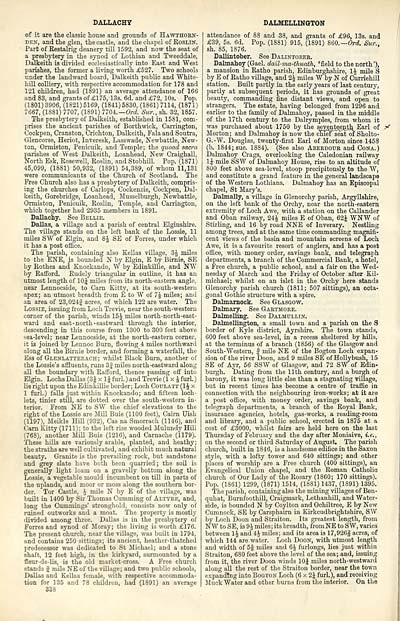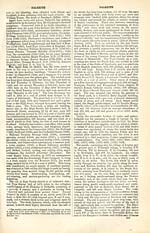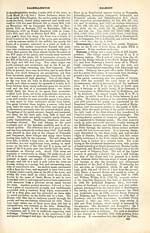Ordnance gazetteer of Scotland
(346) Page 338
Download files
Complete book:
Individual page:
Thumbnail gallery: Grid view | List view

DALLACHY
of it are the classic house and grounds of Hawthorn -
den, and the glen, the castle, and the chapel of Roslist.
Part of Restalrig deanery till 1592, and now the seat of
a presbytery in the synod of Lothian and Tweeddale,
Dalkeith is divided ecclesiastically into East and West
parishes, the former a living worth £527. Two schools
under the landward board, Dalkeith public and White-
hill colliery, with respective accommodation for 178 and
121 children, had (1S91) an average attendance of 166
and 83, and grants of £175, 13s. 6d. and £72, 10s. Pop.
(1801)3906, (1821)5169, (1841)5830, (1861)7114, (1871)
7667, (1S81) 7707, (1891) 7704.— Ord. Stir., sh. 32, 1857.
The presbytery of Dalkeith, established in 1581, com-
prises the ancient parishes of Borthwick, Carrington,
Cockpen, Cranston, Crichton, Dalkeith, Fala and Soutra,
Glencorse, Heriot, Inveresk, Lasswade, Newbattle, New-
ton, Ormiston, Penicuik, and Temple; the quoad sacra
parishes of West Dalkeith, Loanhead, New Craighall,
North Esk, Kosewell, Eoslin, and Stobhill. Pop. (1871)
45,099, (1881) 50,932, (1891) 54,389, of whom 11,131
were communicants of the Church of Scotland. The
Free Church also has a presbytery of Dalkeith, compris-
ing the churches of Carlops, Cockenzie, Cockpen, Dal-
keith, Gorebridge, Loanhead, Musselburgh, Newbattle,
Ormiston, Penicuik, Roslin, Temple, and Carrington,
which together had 2935 members in 1891.
Dallachy. See Bellie.
Dallas, a village and a parish of central Elginshire.
The village stands on the left bank of the Lossie, 11
miles SW of Elgin, and 8J SE of Forres, under which
it has a post office.
The parish, containing also Kellas village, 3£ miles
to the ENE, is bounded N by Elgin, E by Birnie, SE
by Rothes and Knockando, W by Edinkillie, and NW
by Rafford. Rudely triangular in outline, it has an
utmost length of 10J miles from its north-eastern angle,
near Lennocside, to Cam Kitty, at its south-western
apex; an utmost breadth from E to W of 7 J miles; and
an area of 23,024f acres, of which 122 are water. The
Lossie, issuing from Loch Trevie, near the south-western
corner of the parish, winds 15J miles north-north-east-
ward and east -north -eastward through the interior,
descending in this course from 1300 to 300 feet above
sea-level; near Lennocside, at the north-eastern corner,
it is joined by Lennoc Burn, flowing 4 miles northward
along all the Birnie border, and forming a waterfall, the
Ess of Glenlattep.ach; whilst Black Burn, another of
the Lossie's affluents, runs 3| miles north-eastward along
all the boundary with Ptafford, thence passing off into
Elgin. Lochs DaUas (3J x 1£ furl. ) and Trevie (1 x J furl. )
lie right upon the Edinkillie border; Loch Coulatt (1J x
1 furl.) falls just within Knockando; and fifteen loch-
lets, tinier still, are dotted over the south-western in-
terior. From NE to SW the chief elevations to the
right of the Lossie are Mill Buie (1100 feet), Cairn Uish
(1197), Meikle Hill (932), Cas na Smorrach (1146), and
Cam Kitty (1711); to the left rise wooded Mulundy Hill
(768), another Mill Buie (1216), and Camache (1179).
These hills are variously arable, planted, and heathy;
the straths are well cultivated, and exhibit much natural
beauty. Granite is the prevailing rock, but sandstone
and grey slate have both been quarried; the soil is
generally light loam on a gravelly bottom along the
Lossie, a vegetable mould incumbent on till in parts of
the uplands, and moor or moss along the southern bor-
der. Tor Castle, J mile N by E of the village, was
built in 1400 by Sir Thomas Gumming of Altyre, and,
long the Cummings' stronghold, consists now only of
ruined outworks and a moat. The property is mostly
divided among three. Dallas is in the presbytery of
Forres and synod of Moray; the living is worth £176.
The present church, near the village, was built in 1794,
and contains 250 sittings; its ancient, heather-thatched
predecessor was dedicated to St Michael; and a stone
shaft, 12 feet high, in the kirkyard, surmounted by a
fleur-de-lis, is the old market-cross. A Free church
stands J mile NE of the village; and two public schools,
Dallas and Kellas female, with respective accommoda-
tion for 135 and 78 children, had (1891) an average
338
DALMELXINGTON
attendance of 8S and 38, and grants of £96, 13s. and
£39, 5s. 6d. Pop. (1881) 915, (1891) 860.— Ord. Sur.,
sh. 85, 1876.
Dallintober. See Dalintober.
Dalmahoy (Gael, dail-ma-thuath, 'field to the north'),
a mansion in Ratho parish, Edinburghshire, 1^ mile S
by E of Ratho village, and 2J miles W by N of Curriehill
station. Built partly in the early years of last century,
partly at subsequent periods, it has grounds of great
beauty, commanding fine distant views, and open to
strangers. The estate, having belonged from 1296 and
earlier to the family of Dalmahoy, passed in the middle
of the 17th century to the Dalrymples, from whom it
was purchased about 1750 by the seventeenth^ Earl of
Morton; and Dalmahoy is now the cmeiseatof Sholto-
G.-W. Douglas, twenty -first Earl of Morton since 1458
(b. 1844; sue. 1884). (See also Aberdour and Cona.)
Dalmahoy Crags, overlooking the Caledonian railway
1| mile SSW of Dalmahoy House, rise to an altitude of
800 feet above sea-level, stoop precipitously to the W,
and constitute a grand feature in the general landscape
of the Western Lothians. Dalmahoy has an Episcopal
chapel, St Mary's.
Dalmally, a village in Glenorchy parish, Argyllshire,
on the left bank of the Orchy, near the north-eastern
extremity of Loch Awe, with a station on the Callander
and Oban railway, 24J miles E of Oban, 62J WNW of
Stirling, and 16 by road NNE of Inverary. Nestling
among trees, and at the same time commanding magnifi-
cent views of the basin and mountain screens of Loch
Awe, it is a favourite resort of anglers, and has a post
office, with money order, savings bank, and telegraph
departments, a branch of the Commercial Bank, a hotel,
a Free church, a public school, and a fair on the Wed-
nesday of March and the Friday of October after Kil-
michael; whilst on an islet in the Orchy here stands
Glenorchy parish church (1811; 507 sittings), an octa-
gonal Gothic structure with a spire.
Dahnarnock. See Glasgow.
Dalmary. See Gartmoee.
Dalmellrng. See Dalmuxlin.
Dalmellington, a small town and a parish on the S
border of Kyle district, Ayrshire. The town stands,
600 feet above sea-level, in a recess sheltered by hills,
at the terminus of a branch (1856) of the Glasgow and
South-Western, f mile NE of the Bogton Loch expan-
sion of the river Doon, and 9 miles SE of Holly bush, 15
SE of Ayr, 56 SSW of Glasgow, and 72 SW of Edin-
burgh. Dating from the 11th century, and a burgh of
barony, it was long little else than a stagnating village,
but in recent times has become a centre of traffio in
connection with the neighbouring iron- works; at it are
a post office, with money order, savings bank, and
telegraph departments, a branch of the Royal Bank,
insurance agencies, hotels, gas-works, a reading-room
and library, and a public school, erected in 1875 at a
cost of £3000, whilst fairs are held here on the last
Thursday of February and the day after Moniaive, i.e.,
on the second or third Saturday of August. The parish
church, built in 1846, is a handsome edifice in the Saxon
style, with a lofty tower and 640 sittings; and other
places of worship are a Free church (400 sittings), an
Evangelical Union chapel, and the Roman Catholio
church of Our Lady of the Rosary (1860; 170 sittings).
Pop. (1861) 1299, (1871) 1514, (1881) 1437, (1891) 1395.
The parish, containing also the mining villages of Ben-
quhat, Burnfoothill, Craigmark, Lethanhill, and Water-
side, is bounded N by Coylton and Ochiltree, E by New
Cumnock, SE by Carsphairn in Kirkcudbrightshire, SW
by Loch Doon and Straiton. Its greatest length, from
NW to SE, is 9J miles; its breadth, fromNE to SW, varies
between 1J and 4 J miles; and its area is 17,926jj acre9, of
which 144 are water. Loch Doon, with utmost length
and width of 5jj miles and 6J furlongs, lies just within
Straiton, 680 feet above the level of the sea; and, issuing
from it, the river Doon winds 10 J miles north-westward
along all the rest of the Straiton border, near the town
expanding into Bogton Loch (6 x 2 J furl.), and receiving
Muck Water and other burns from the interior. On the
of it are the classic house and grounds of Hawthorn -
den, and the glen, the castle, and the chapel of Roslist.
Part of Restalrig deanery till 1592, and now the seat of
a presbytery in the synod of Lothian and Tweeddale,
Dalkeith is divided ecclesiastically into East and West
parishes, the former a living worth £527. Two schools
under the landward board, Dalkeith public and White-
hill colliery, with respective accommodation for 178 and
121 children, had (1S91) an average attendance of 166
and 83, and grants of £175, 13s. 6d. and £72, 10s. Pop.
(1801)3906, (1821)5169, (1841)5830, (1861)7114, (1871)
7667, (1S81) 7707, (1891) 7704.— Ord. Stir., sh. 32, 1857.
The presbytery of Dalkeith, established in 1581, com-
prises the ancient parishes of Borthwick, Carrington,
Cockpen, Cranston, Crichton, Dalkeith, Fala and Soutra,
Glencorse, Heriot, Inveresk, Lasswade, Newbattle, New-
ton, Ormiston, Penicuik, and Temple; the quoad sacra
parishes of West Dalkeith, Loanhead, New Craighall,
North Esk, Kosewell, Eoslin, and Stobhill. Pop. (1871)
45,099, (1881) 50,932, (1891) 54,389, of whom 11,131
were communicants of the Church of Scotland. The
Free Church also has a presbytery of Dalkeith, compris-
ing the churches of Carlops, Cockenzie, Cockpen, Dal-
keith, Gorebridge, Loanhead, Musselburgh, Newbattle,
Ormiston, Penicuik, Roslin, Temple, and Carrington,
which together had 2935 members in 1891.
Dallachy. See Bellie.
Dallas, a village and a parish of central Elginshire.
The village stands on the left bank of the Lossie, 11
miles SW of Elgin, and 8J SE of Forres, under which
it has a post office.
The parish, containing also Kellas village, 3£ miles
to the ENE, is bounded N by Elgin, E by Birnie, SE
by Rothes and Knockando, W by Edinkillie, and NW
by Rafford. Rudely triangular in outline, it has an
utmost length of 10J miles from its north-eastern angle,
near Lennocside, to Cam Kitty, at its south-western
apex; an utmost breadth from E to W of 7 J miles; and
an area of 23,024f acres, of which 122 are water. The
Lossie, issuing from Loch Trevie, near the south-western
corner of the parish, winds 15J miles north-north-east-
ward and east -north -eastward through the interior,
descending in this course from 1300 to 300 feet above
sea-level; near Lennocside, at the north-eastern corner,
it is joined by Lennoc Burn, flowing 4 miles northward
along all the Birnie border, and forming a waterfall, the
Ess of Glenlattep.ach; whilst Black Burn, another of
the Lossie's affluents, runs 3| miles north-eastward along
all the boundary with Ptafford, thence passing off into
Elgin. Lochs DaUas (3J x 1£ furl. ) and Trevie (1 x J furl. )
lie right upon the Edinkillie border; Loch Coulatt (1J x
1 furl.) falls just within Knockando; and fifteen loch-
lets, tinier still, are dotted over the south-western in-
terior. From NE to SW the chief elevations to the
right of the Lossie are Mill Buie (1100 feet), Cairn Uish
(1197), Meikle Hill (932), Cas na Smorrach (1146), and
Cam Kitty (1711); to the left rise wooded Mulundy Hill
(768), another Mill Buie (1216), and Camache (1179).
These hills are variously arable, planted, and heathy;
the straths are well cultivated, and exhibit much natural
beauty. Granite is the prevailing rock, but sandstone
and grey slate have both been quarried; the soil is
generally light loam on a gravelly bottom along the
Lossie, a vegetable mould incumbent on till in parts of
the uplands, and moor or moss along the southern bor-
der. Tor Castle, J mile N by E of the village, was
built in 1400 by Sir Thomas Gumming of Altyre, and,
long the Cummings' stronghold, consists now only of
ruined outworks and a moat. The property is mostly
divided among three. Dallas is in the presbytery of
Forres and synod of Moray; the living is worth £176.
The present church, near the village, was built in 1794,
and contains 250 sittings; its ancient, heather-thatched
predecessor was dedicated to St Michael; and a stone
shaft, 12 feet high, in the kirkyard, surmounted by a
fleur-de-lis, is the old market-cross. A Free church
stands J mile NE of the village; and two public schools,
Dallas and Kellas female, with respective accommoda-
tion for 135 and 78 children, had (1891) an average
338
DALMELXINGTON
attendance of 8S and 38, and grants of £96, 13s. and
£39, 5s. 6d. Pop. (1881) 915, (1891) 860.— Ord. Sur.,
sh. 85, 1876.
Dallintober. See Dalintober.
Dalmahoy (Gael, dail-ma-thuath, 'field to the north'),
a mansion in Ratho parish, Edinburghshire, 1^ mile S
by E of Ratho village, and 2J miles W by N of Curriehill
station. Built partly in the early years of last century,
partly at subsequent periods, it has grounds of great
beauty, commanding fine distant views, and open to
strangers. The estate, having belonged from 1296 and
earlier to the family of Dalmahoy, passed in the middle
of the 17th century to the Dalrymples, from whom it
was purchased about 1750 by the seventeenth^ Earl of
Morton; and Dalmahoy is now the cmeiseatof Sholto-
G.-W. Douglas, twenty -first Earl of Morton since 1458
(b. 1844; sue. 1884). (See also Aberdour and Cona.)
Dalmahoy Crags, overlooking the Caledonian railway
1| mile SSW of Dalmahoy House, rise to an altitude of
800 feet above sea-level, stoop precipitously to the W,
and constitute a grand feature in the general landscape
of the Western Lothians. Dalmahoy has an Episcopal
chapel, St Mary's.
Dalmally, a village in Glenorchy parish, Argyllshire,
on the left bank of the Orchy, near the north-eastern
extremity of Loch Awe, with a station on the Callander
and Oban railway, 24J miles E of Oban, 62J WNW of
Stirling, and 16 by road NNE of Inverary. Nestling
among trees, and at the same time commanding magnifi-
cent views of the basin and mountain screens of Loch
Awe, it is a favourite resort of anglers, and has a post
office, with money order, savings bank, and telegraph
departments, a branch of the Commercial Bank, a hotel,
a Free church, a public school, and a fair on the Wed-
nesday of March and the Friday of October after Kil-
michael; whilst on an islet in the Orchy here stands
Glenorchy parish church (1811; 507 sittings), an octa-
gonal Gothic structure with a spire.
Dahnarnock. See Glasgow.
Dalmary. See Gartmoee.
Dalmellrng. See Dalmuxlin.
Dalmellington, a small town and a parish on the S
border of Kyle district, Ayrshire. The town stands,
600 feet above sea-level, in a recess sheltered by hills,
at the terminus of a branch (1856) of the Glasgow and
South-Western, f mile NE of the Bogton Loch expan-
sion of the river Doon, and 9 miles SE of Holly bush, 15
SE of Ayr, 56 SSW of Glasgow, and 72 SW of Edin-
burgh. Dating from the 11th century, and a burgh of
barony, it was long little else than a stagnating village,
but in recent times has become a centre of traffio in
connection with the neighbouring iron- works; at it are
a post office, with money order, savings bank, and
telegraph departments, a branch of the Royal Bank,
insurance agencies, hotels, gas-works, a reading-room
and library, and a public school, erected in 1875 at a
cost of £3000, whilst fairs are held here on the last
Thursday of February and the day after Moniaive, i.e.,
on the second or third Saturday of August. The parish
church, built in 1846, is a handsome edifice in the Saxon
style, with a lofty tower and 640 sittings; and other
places of worship are a Free church (400 sittings), an
Evangelical Union chapel, and the Roman Catholio
church of Our Lady of the Rosary (1860; 170 sittings).
Pop. (1861) 1299, (1871) 1514, (1881) 1437, (1891) 1395.
The parish, containing also the mining villages of Ben-
quhat, Burnfoothill, Craigmark, Lethanhill, and Water-
side, is bounded N by Coylton and Ochiltree, E by New
Cumnock, SE by Carsphairn in Kirkcudbrightshire, SW
by Loch Doon and Straiton. Its greatest length, from
NW to SE, is 9J miles; its breadth, fromNE to SW, varies
between 1J and 4 J miles; and its area is 17,926jj acre9, of
which 144 are water. Loch Doon, with utmost length
and width of 5jj miles and 6J furlongs, lies just within
Straiton, 680 feet above the level of the sea; and, issuing
from it, the river Doon winds 10 J miles north-westward
along all the rest of the Straiton border, near the town
expanding into Bogton Loch (6 x 2 J furl.), and receiving
Muck Water and other burns from the interior. On the
Set display mode to: Large image | Transcription
Images and transcriptions on this page, including medium image downloads, may be used under the Creative Commons Attribution 4.0 International Licence unless otherwise stated. ![]()
| Gazetteers of Scotland, 1803-1901 > Ordnance gazetteer of Scotland > (346) Page 338 |
|---|
| Permanent URL | https://digital.nls.uk/97397398 |
|---|

